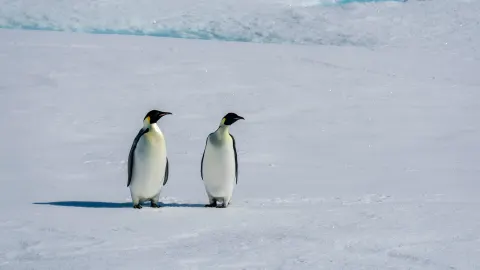Aug 26 – More than 9,000 emperor penguin chicks were probably killed as ice broke up early in Antarctica last year, in what scientists called a “catastrophic breeding failure.”
A study, published Thursday in Nature’s Communications Earth & Environment journal, used satellite images to examine five penguin breeding sites in the Bellingshausen Sea region, which lies to the west of the Antarctic Peninsula and was the area worst affected by last year’s record low levels of sea ice. The researchers found that four of the five emperor penguin colonies they studied were abandoned before the chicks would have been old enough to fledge — meaning that it was unlikely that any survived.
Emperor penguins usually lay their eggs in May or June, but the chicks must remain on the ice until they fledge in the southern hemisphere summer, in December or January. Before this point, the young birds lack the waterproof feathers they need to survive in the water.
Any melting or breakup of sea ice before this is catastrophic, as the chicks “will go into the water and either drown or freeze to death even if they do get back out,” Peter Fretwell, the study’s lead author and geographic information officer at the British Antarctic Survey, said in a telephone interview Friday. “Now, we saw this happened all over Antarctica, at many sites.”
Of the emperor penguin’s 62 known breeding sites across Antarctica, 19 suffered some breeding failure, with complete failure in six, according to Fretwell.
And the impact on the penguins’ breeding patterns is expected to continue into this year, as sea ice formation only began in late June — months later than normal. By then, “the emperors should have been sitting on their eggs already,” Fretwell said.
“So it’s inevitable that in the Bellingshausen Sea there will be virtually no breeding, we don’t think, this year. For the rest of the continent, we’re waiting for the sun to come up to see what the consequences of this extremely low sea ice year are going to be.”
The penguins normally arrive at their breeding sites in late March to April, where they lay and hatch their eggs.
Emperors are the world’s tallest and heaviest species of penguin, but only lay a single egg each year. As they rely on stable sea ice that is firmly attached to the shore to reproduce, they are particularly vulnerable to the effects of climate change. Last year, the U.S. Fish and Wildlife Service granted the species federal protections under the Endangered Species Act.
The team used satellite imagery to monitor the presence of distinctive brown stains on the ice from the birds’ excrement, known as guano, which indicates the presence of emperor penguin populations.



























































